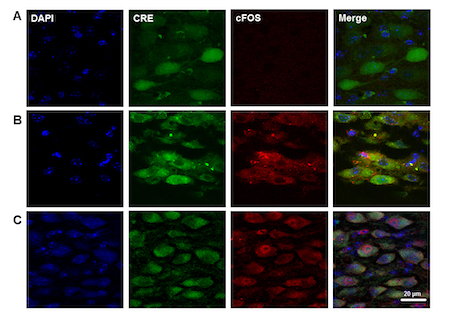Research
Our laboratory focuses on determining the genetic and molecular signals for physiological mechanism of neural plasticity and ventilatory acclimatization to chronic hypoxia. We study healthy people from sea level and adapted to high altitude in the Andes and Tibet, as well as patients with chronic lung disease and animal models, including transgenic mice. Our studies are relevant to lung disease causing chronic sustained hypoxia and chronic mountain sickness, and sleep apnea that causes intermittent hypoxia. We are especially interested in mechanisms of susceptibility and tolerance to chronic hypoxia in microcircuits that control breathing in the central nervous system.
 |
Micrographs of neurons in respiratory centers of the brainstem of: (A) normoxic mice, (B) mice in hypoxia for 3 hrs, and (C) mice in hypoxia for 7 days. DAPI shows cell nuclei and CRE shows AAV-infected neurons expressing Cre-recombinase, which will delete the HIF-1α gene in these transgenic mice. cFOS shows neurons activated by hypoxia and the merged image shows neurons activated by hypoxia will have their HIF-1α gene deleted by CRE. |
Our recent experiments study:
- The effects of HIF-1α versus HIF-2α in neurons versus glia for plasticity in the CSN with chronic hypoxia.
- The role of glia and inflammatory signals in acclimatization to chronic hypoxia.
- Identifying therapeutic targets for manipulating neural plasticity in respiratory centers arising from chronic sustained versus intermittent hypoxia.
- Genetic determinants of individual variation in the hypoxic ventilatory response, including adaptions in human populations native to high altitude.
- Plasticity in the control of breathing in patients with chronic hypoxemia from lung disease.
We study the problem at multiple levels, translating from genetic and molecular mechanisms to the whole animal physiology. Experimental approaches include:
- ventilatory responses, respiratory gas exchange and functional MRI in healthy humans during acclimatization to hypoxia at high altitude, and in patients with sleep apnea receiving various treatments,
- measuring ventilatory responses, metabolism and respiratory muscle activity in conscious, freely moving, instrumented rats and transgenic mice,
- temporally and spatially specific conditional gene deletion using loxP-Cre strategies in transgenic mice,
- neurophysiological studies of chemoreceptor reflexes in anesthetized rats and mice
- in vivo and confocal fluorescent imaging, immunohistochemistry and molecular biological measures of signals for neural plasticity.
Our laboratory also continues to make in gas exchange measurements in humans and various animal models. These studies are generally focused on gas exchange limitations (diffusion limitation, ventilation-perfusion heterogeneity), breath testing (e.g. alcohol) and blood sampling (non-invasive measures of gas levels in blood), and comparative physiology (animal models of human gas exchange and lung disease).
Frank's UCSD Profiles page lists his past publications and current grants.
